Here’s Why Taco Bell Added Artificial Intelligence Technology To Its Mobile App – Forbes

Taco Bell has added AI to its mobile app, offering personalized menu suggestions for heavy users … [+] (Photo by Justin Sullivan/Getty Images)
Getty Images
Artificial intelligence was identified by a number of restaurant tech providers as a top trend for 2020 and, so far, those predictions seem pretty spot on.
Up until now, we’ve seen just a surface scratch of AI’s potential in the restaurant space, with chains like Chick-fil-A quietly leveraging the technology to identify food safety issues, and TGI Fridays using it to sell more alcohol, for example.
But thanks in large part to McDonald’s $300 million investment in Dynamic Yield last March, AI is no longer an under-the-radar experimentation.
And now, Taco Bell is making its case for AI, announcing a broader partnership with Certona last week to create a more personalized experience for its mobile app users, of which there are 5 million.
Through the technology, machine learning derives the most relevant menu items for app users and also pushes promotions and content based on an individual customer’s behavior. Similar to how McDonald’s is using Dynamic Yield’s technology at the drive-thru, the Certona technology also differentiates menu items and pricing based on region.
Derrick Chan, Taco Bell’s director of e-commerce, provided a layman’s explanation on how it works.
“Instead of displaying generic, or static, product recommendations, we use Certona’s AI engine to determine what the best products are to display to a customer. So, for example, if it is a first-time user, we are mostly factoring in overall sales data, such as what four items best sell with the item currently being viewed,” Chan said.
The AI also considers factors like time of day, day of week, weather, etc. And, if that same user viewed multiple products, then all of those products are also taken into consideration.
“For a returning user, we also factor in their [like] previous purchases, product views,” Chan said. “In a nutshell, this is similar to how Amazon provides personalized product recommendations. We’re just doing the same thing for food.”
And, perhaps because of Amazon–which counts 95 million Prime members in the U.S. alone–consumers are quickly coming to expect such relevant content from their favorite brands.
Early signs point to some interesting businesses cases for restaurant brands using AI.
Last week, Starbucks President and CEO Kevin Johnson told the National Retail Federation Show crowd about the company’s Deep Brew (AI) technology, calling it a “key part” of Starbucks’ future. According to Restaurant Dive, the technology calculates a store’s inventory needs and predicts how many baristas are needed behind the counter every day, freeing up their time to interact with customers.
Also at the NRF, Domino’s touted its AI efforts via Nvidia GPUs. The company uses the system to predict when an order will be ready, improving the accuracy rate to 95%.
Chick-fil-A’s AI system, hosted by AWS, can spot signs of foodborne illness with nearly 80% accuracy.
Then there’s the Colorado-based Good Times Burger & Frozen Custard case study, which implemented Valyant AI at its drive-thrus. Valyant CEO Rob Carpenter told Restaurant Dive that an AI product can increase profitability 10% to 30% by increasing throughput, upselling, automating mundane tasks and providing other labor savings.
For McDonald’s, it’s still early, but in October then-CEO Steve Easterbrook told investors that the business case for Dynamic Yield’s AI system is “driving rapid adoption.” New CEO Chris Kempczinski backed this up in early January, telling CNBC that the Dynamic Yield investment is “tangibly driving check growth.” The technology was expected to be rolled out systemwide at the end of 2019, so we’ll perhaps get more color on its value when McDonald’s reports its Q4 results within the next couple of weeks.
Taco Bell’s biggest objective is to create a more personalized experience, and putting these capabilities in front of its heavy-user mobile customers is a great place to gauge the technology’s effectiveness.
“With that personalization and relevancy comes exposure to new menu offerings, customizations and opportunities for our fans to engage with the brand in a new and innovative way,” Chan said.
Notably, Taco Bell isn’t just focused on mobile app customers. Chan said the brand is currently testing other consumer touchpoints to deploy the technology and will have more to share in the “near future.”
Though Chan declined to share specifics from its year-long test with Certona’s technology, he adds “we’re seeing great results” and the possibility “absolutely” exists to expand the tech to other channels.
Because of these early learnings, he believes it’s no longer a question of “if” but “when” AI reaches critical mass in the space. Indeed, other chains have hinted at their impending adoption–or expanded adoption–of AI, including digital heavyweights Chipotle and Panera.
“AI is no longer a vague and unknown topic. In many cases, it’s a customer expectation,” Chan said. “From purchasing patterns, suggested ads on social media to what to binge watch next, personalization brings ease and convenience for consumers. With that proliferation comes comfortability and permissibility for our consumers.”
As the restaurant space navigates unprecedented competition and saturation, such personalization has become a key advantage, particularly as more consumers are growing to expect the so-called Amazon treatment. A recent report from PSFK showed that nearly 80% of diners want personalized menu recommendations. That is simply too big of a number for restaurant chains to ignore.






